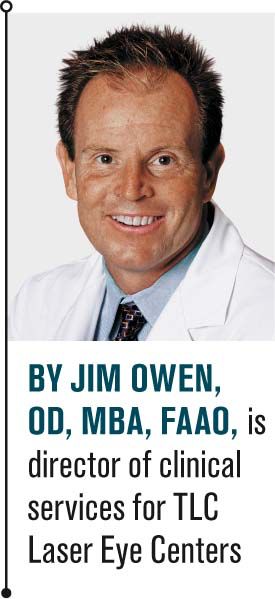Why I changed what I tell patients about refractive surgery
Refractive surgery is no stranger to evolving technology and research. Jim Owen, OD, MBA, FAAO, explains how recent research has changed the way he positions laser vision correction with his patients.


Over the past 20 years, laser vision correction has improved dramatically. Flying-spot lasers have replaced broad beam lasers, the femtosecond laser has replaced the microkeratome, and Scheimpflug images have replaced Placido disc topography. With these changes in technology, has optometry’s narrative changed?
While “20/happy” is still the goal and a phrase I use each day, how we position laser vision correction with patients seems stale. A few studies have changed what I tell patients about laser vision correction.
What research says
A 2017 study examines laser vision correction patients (90.9 percent laser-assisted in situ keratomileusis [LASIK]) from 45 medical institutions in Japan during 2013.1
The data is based on three-month, postoperative visits from 131 ophthalmologists. These surgeons used nine different excimer lasers and five different femtosecond lasers to create a LASIK flap.1 Some 95.9 percent of LASIK patients achieved 20/20 or better. This data compares favorably to published FDA data from the Contoura (Alcon) platform with 92.6 percent 20/20 or better and iDesign (Johnson & Johnson Vision) with 94 percent 20/20 or better. 2,3
Previously from Dr. Owen: Femtosecond advances help ODs, patients
A controlled group of patients was used to compile the FDA data, but the Japanese data comprised patients who visited Japanese clinics over the course of a year. By contrast, the original FDA approval for the VISX excimer laser system in 1996 was 63.7 percent 20/20.4
LASIK complications
In the Japanese study, researchers reported 0.8 percent of patients had the following three LASIK complications combined-diffuse lamellar keratitis, flap striae, and epithelial ingrowth. The most common complication was dry eye at 1.2 percent.
Schallhorn et al reported on 32,569 LASIK eyes in 2009, finding less than 1 percent of the three complications combined. This study also found less than 1 percent dry eye, but it is not known if the criteria for dry eye was the same as for the Japanese study.1,5
A 2009 study of 4,772 eyes compared the 15 kHz femtosecond laser to the 30 kHz laser (we are now at 150 kHz) and found less than 1 percent of patients had flap complications.6 A meta-analysis of three FDA filings for the Alcon, Abbott Medical Optics, and Nidek lasers found significant decrease in symptoms of light sensitivity, night driving, and halos.7
Contact lenses vs. glasses
Patients elect to wear contact lenses for some of the same reasons they opt to have laser vision correction-they do not want to wear glasses. This results in comparisons between LASIK and contact lenses regarding risk, patient satisfaction, and so on.
Related: How to manage vision changes over time post-LASIK
If you randomly ask 100 people if they are afraid of wearing contact lenses few would say yes, but when asked about eye surgery I am guessing the number is much higher. An estimated 41 million Americans wear contact lenses, while only 700,000 LASIK procedures are performed each year.8,9
Surveys show mixed reviews
A three-year prospective survey compared contact lens patients; patients who wore contact lenses only, then moved to LASIK; and patients who wore contact lenses, then moved to LASIK. This study enrolled 1,800 patients across 20 sites in the U.S.10 The primary end point was visual satisfaction.
This study stands out because researchers examined baseline data prior to surgery and surveyed patients before surgery, one year postop, and three years postop.
In the group which continued contact lens wear only, 63 percent of respondents said they “strongly agree” with the statement, “I would recommend my current method of vision correction to a close friend or relative.”
In the group which started with contact lens wear and moved to LASIK, 40 percent responded “strongly agree” with the statement, “I would recommend my current method of vision correction to a close friend or relative.”
In the contact lens-only group, 54 percent of contact lens wearers responded after three years they “strongly agree” with the statement, “I would recommend my current method of vision correction to a close friend or relative.” This compares to the two LASIK groups in which 88 percent of those who previously wore contact lenses and 77 percent of those who previously wore glasses responded they would “strongly” recommend LASIK.
About 1 percent of respondents in each group at each time period responded they “strongly disagree” with the statement, “I would recommend my current method of vision correction to a close friend or relative.”
Researchers also surveyed subjects about night driving, starbursts, dry eye, and eye infections. In the contact lenses-only group, the percentage of patients who respond they had no difficulty driving at night remained virtually the same over three years. Some 36 percent of respondents had no night driving difficulty at baseline, and 37 percent had none at three years.
Related: Measuring LASIK patient satisfaction
For the contact lens to LASIK group, 60 percent had no problems driving at night at baseline; at the three-year mark more than 60 percent had no night driving problems. Glasses wearers who did not suffer from night driving problems improved from 44 percent to 57 percent. As compared to contact lens wearers, LASIK patients reported better vision while driving at night.

Dryness happens
Dry eyes are the most common side effect of LASIK, but opinions of patients who have had LASIK vary about the dryness of their eyes three years after surgery.5 The control group remained the same from baseline to the three-year reporting period with 29 percent indicating they do not feel dry at all. In the contact lens group, there was improvement from 44 percent not feeling dry eye at baseline to 50 percent at three years. The glasses group went from 51 percent to 42 percent at three years and significantly fewer patients reported dryness than the group who remained in contact lenses.
For both the contact lens-only group and the contact lens to LASIK group, 1 percent reported feeling dry “all the time” at all reporting periods. For the cohort of patients, patients who felt the driest in their contact lenses did not have surgery. After surgery, the LASIK patients felt better than the contact lens patients.
When asked about experiencing eye infections in the past year, 8 percent of contact lens-only patients and 3 percent of both LASIK groups said yes. A similar trend was shown for questions about ulcer and abrasion. The risk of an eye infection is low but appears less likely with LASIK over time.
Ask the right questions
Laser vision correction is not for everyone, and eye surgery may be scary for many patients. It is worth your time and a benefit to your patient to ask, “What are you fearful of with surgery?” I ask this question often, and the most common answer is, “I do not know, it is just scary.”
New technology has reduced the risks and complications of laser vision correction. Understanding a patient’s subjective symptoms of glare, halos, night driving, and dryness before surgery go a long way in determining what symptoms will be after surgery. Ask your patients the right questions when they inquire about surgery-it will help to deliver “20/happy” patients.
References
1. Kamiya K, Igarashi A, Hayashi K, Negishi K, Sato M, Bissen-Miyajima H; Survey Working Group of the Japanese Society of Cataract and Refractive Surgery. A Multicenter Retrospective Survey of Refractive Surgery in 78,248 Eyes. J Refract Surg. 2017 Sep 1;33(9):598-602.
2. WaveLight. Allegretto Wave Eye-Q. Available at: https://www.accessdata.fda.gov/cdrh_docs/pdf2/P020050S012d.pdf. Accessed 1/12/18.
3. U.S. Food & Drug Administration. Summary of Safety and Effectiveness Data (SSED). Available at: https://www.accessdata.fda.gov/cdrh_docs/pdf/P930016S044b.pdf. Accessed 1/12/18.
4. Department of Health and Human Services. Memorandum. Available at: https://www.accessdata.fda.gov/cdrh_docs/pdf/p930016.pdf. Accessed 1/12/18.
5. Schallhorn SC, Venter, JA. One-month Outcomes of Wavefront-guided LASIK for Low to Moderate Myopia With the VISX STAR S4 Laser in 32,569 Eyes. J Refract Surg. 2009 Jul;25(7 Suppl):S634-41.
6. Haft P, Yoo SH, Kymionis GD, Ide T, O'Brien TP, Culbertson WW. Complications of LASIK flaps made by the IntraLase 15- and 30-kHz femtosecond lasers. J Refract Surg. 2009 Nov;25(11):979-84.
7. Moshirfar M, Shah TJ, Skanchy DF, Linn SH, Durrie DS. Meta-analysis of the FDA Reports on Patient-Reported Outcomes Using the Three Latest Platforms for LASIK. J Refract Surg. 2017 Jun 1;33(6):362-368.
8. Cope JR, Collier SA, Rao MM, Chalmers R, Mitchell GL, Richdale K, Wagner H, Kinoshita BT, Lam DY, Sorbara L, Zimmerman A, Yoder JS, Beach MJ. Contact Lens Wearer Demographics and Risk Behaviors for Contact Lens-Related Eye Infections - United States, 2014. MMWR Morb Mortal Wkly Rep. 2015;64(32): 865–870.
9. USA Today. What are the major benefits of laser eye surgery? Available at: http://classifieds.usatoday.com/blog/services/major-benefits-laser-eye-surgery/. Accessed 1/23/18.
10. Price MO, Price DA, Bucci FA Jr, Durrie DS, Bond WI, Price FW Jr. Three-Year Longitudinal Survey Comparing Visual Satisfaction with LASIK and Contact Lenses. Ophthalmology. 2016 Aug;123(8):1659-1666.
Newsletter
Want more insights like this? Subscribe to Optometry Times and get clinical pearls and practice tips delivered straight to your inbox.




.png&w=3840&q=75)











